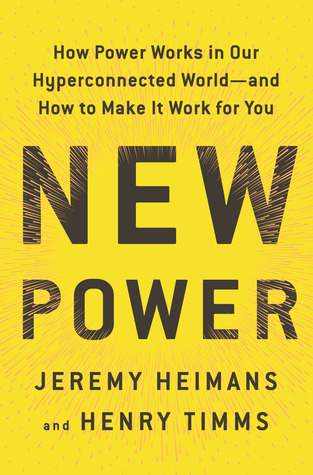More on this book
Community
Kindle Notes & Highlights
Read between
April 5 - August 27, 2018
The conventional wisdom is that network effects at work around platforms like Uber will lead inexorably toward a national and perhaps global monopoly or duopoly emerging (and that is certainly Uber’s goal). Yet, as Deshotel reminded us, 90 percent of ridesharing is purely local. It is a service fairly well suited to a city scale and a more communitarian bent,
These platforms are empty vessels without us, and we determine whether they thrive or falter. As we choose whether or not to participate, we have an obligation to consider more than whether new power communities delight or make things easier for us, but also whether they are helping or harming the world all around us.
At Davos in 2016 an installation full of innovation buzzwords offered what at first glance seemed to be a new and exciting possibility: “What if public infrastructure was funded by the crowd?” Harvard law professor Jonathan Zittrain took a photo of the installation and added the caption, “Or as some would call it, ‘taxes.’
How do we reconcile a world of ever-proliferating “leaderless” movements like Occupy Wall Street and the Arab Spring, but also ever-proliferating strongmen like Russia’s Putin, Turkey’s Erdoǧan, and Egypt’s el-Sisi?
“Other recent attempts have failed because they were either so ‘top-down’ and/or poorly-managed that they choked volunteer leadership and enthusiasm; or because they were so dogmatically fixated on pure peer-to-peer or ‘bottom-up’ organizing that they rejected basic management, accountability and planning.
He has no need for a Ministry of Truth to ensure that one state-sponsored opinion is held by all. In fact, he revels in the instability of countless truths. The more the merrier.
This combination of an old power, authoritarian value set and a sideways, unstructured new power model lies behind some of the most potent and dangerous leadership models in the world today. This is precisely the combination that ISIS deploys—it offers a return to order and certainty (namely, a brutal medieval order) but spreads that message with savvy, decentralized control.
A challenge for leader-full and women-led movements will be getting the old power structure to see and engage with them for what they are, rather than trying to turn themselves into something those existing structures can recognize.
The journey—and philosophy—of Perry and his co-founders shows the path that might take us away from a life of participation farms, and toward one that is less extractive and more socially generative: platforms that meet the “circle test.”
What might a formula designed to favor the interests of platform participants and society at large—instead of just their owners, advertisers, and investors—look like?
the inputs into the algorithm, which shape what content we see and what gets priority, would be fully transparent to the user,
“filter in” perspectives and views from those well outside their bubbles.
we might imagine, too, the intermediaries being removed from the mega-platforms of the world—our Ubers or Airbnbs—when drivers and riders, or hosts and guests, work out ways to collaborate and exchange directly with each other.
“We believe that modern journalists shouldn’t see their readers as a passive group of annoying followers. Instead, they should regard readers as a potential gold mine of expert information.” This comes to life in many ways at De Correspondent. Every journalist shares their story idea or the question they want to investigate with members before they write a single word. Readers are then invited to draw on their expertise in that topic and share insights, ideas, or leads. Readers are given tools to curate, build on, and adapt material from the newspaper, adding external sources and their own
...more
Some of this is already happening, especially at the city level. Participatory budgeting is an idea that started decades ago in the Brazilian city of Porto Alegre but is now spreading throughout the world and merging with internet crowdsourcing culture. Paris’s ambitious participatory budgeting program, led by Mayor Anne Hidalgo, has led to hundreds of thousands of Parisians passionately debating and voting on projects close to their daily lives, everything from greening public space to aiding the homeless.
Plans like this must account for the bias inherent in any crowdsourcing exercise—especially the challenge of distinguishing between what is vital and what has viral appeal, and ensuring that they don’t mostly benefit the already privileged. But done well, they can serve a larger purpose: giving people a sense of ownership and many more opportunities to participate.


